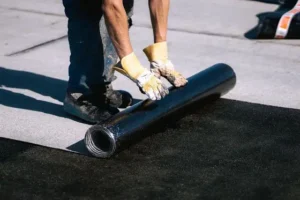Waterproofing is a vital layer in construction for areas like bathrooms, basements, and roofs, where water ingress is common. Effective waterproofing minimizes structural damage, provides a comfortable living environment, and mitigates issues such as leakage, dampness, and mold. Waterproofing is usually a complex process and many issues can arise that influence a structure’s waterproofing system. In this article, we explore the issues in waterproofing construction and recommend solutions for resolving those issues in order to improve construction quality and ensure long-lasting results.
1. Common Problems in Waterproofing Construction
1.1 Improper Substrate Preparation
Substrate preparation issues rank among the most important factors influencing adhesion and impact waterproofing materials. The most common issues are dirt, grease, water, dust, loose particles on the substrate, uneven surfaces and substrates that are overly wet or dry.
Solution: Ensure that a substrate is prepped properly in terms of surface roughness where bare surfaces require scuffing to remove loose dust, grease and debris, dry substrate, and patching of uneven surfaces. In addition, dry surfaces greatly improve the adhesion of subsequent coating layers.
1.2 Incorrect Waterproofing Material Selection
There are different waterproofing materials and each serves a different purpose and function. Certain materials may not withstand UV rays or high temperatures, while some are only meant for underground usage. Such diverse materials one proposes only works while seeing their own gain due to abuse of usage of materials.
Solution: Selecting waterproofing materials serves based on the requirements is the solution. For instance, distinct materials are needed for roofs. Moreover basements and bathrooms also require specific materials. Always ensure the right material is selected based on the conditions and environment such as humidity, temperature, and sunlight exposure. Always go for materials from trusted brands to avoid cheap low quality products.
1.3 Uneven Waterproofing Layer Thickness
Bathroom and roof sections can suffer damages from lacking waterproof protection. Noticing uneven water proofing layers can cause leakage which is a problem. This problem arises due to inconsistency in materials.”
Solution: Maintain precise restrictions to the waterproofing layers and ensure even distribution during application. Professional tools should be used to perform constant measurements and evaluation. For intricate designs and areas, a better approach may be to apply waterproofing materials in several uniform thin layers that are consistent.
1.4 Non-compliant Construction Practices
Some construction workers may overlook important details in the waterproofing process, such as proper overlap of waterproofing membranes or neglecting to address critical junctions like corners and pipe penetrations. These areas are especially vulnerable to water ingress.
Solution: Pay special attention to detail during the application process. Ensure proper overlap at seams, and use specialized materials to address junctions such as corners and pipe penetrations. Reinforced tape or sealing compounds can be used in these critical areas to prevent water leakage.
1.5 Unsuitable Environmental Conditions for Construction
Construction waterproofing processes are particularly sensitive to weather conditions. Overly hot or cold temperatures and too much moisture can all interfere with the curing and bonding processes. For instance, some materials may not bond appropriately during cold weather.
Before starting any construction, make sure you comprehend the environmental conditions at hand. If extreme weather is anticipated (either scorching or freezing temperatures), use waterproofing materials best suited for those temperatures or use environmentally controlled equipment. Whenever possible, waterproof during optimal weather conditions.
1.6 Lack of Skilled Labor
The waterproofing processes undertaken strongly depend on the skill set and experience of the workers. Some workers may not be trained with adequate knowledge on how to apply the materials, or some may not know the specifications of different materials leading to improper results.
To ensure that these employees abide by the waterproofing procedures apply, tailor-made training programs must be organized. During the technical briefing before the work begins, each worker should clearly understand the construction process and follow the instruction provided..
1.7 Insufficient Curing Time for Waterproofing Layers
One common issue in waterproofing construction is the failure to allow sufficient curing time between layers of the waterproofing material. If layers are applied before the previous layer has fully cured, it can lead to inadequate bonding and eventual failure of the waterproofing system.
Solution: Follow the manufacturer’s recommended curing time between layers to ensure proper bonding. Avoid rushing the process and ensure that the waterproofing system has fully cured before proceeding to the next step.
2. Preventive Measures for Common Waterproofing Problems
2.1 Strict Control of Material Procurement
The quality of waterproofing materials directly affects the performance of the waterproofing system. Always source materials from reputable suppliers and ensure they meet the required standards for the specific application.
2.2 Detailed Construction Plan
Create a detailed construction plan before starting the project, which includes material specifications, construction methods, and quality control checks. This ensures that the project is executed according to the highest standards and reduces the risk of mistakes or missed steps.
2.3 Regular Inspections and Testing
Throughout the waterproofing process, perform regular inspections to ensure that all steps are followed correctly. Pay particular attention to the key areas such as seams, overlaps, and junctions. After the construction is completed, conduct a water leakage test to verify the effectiveness of the waterproofing system.
3. Conclusion
Waterproofing construction is a highly specialized field that requires careful attention to detail at every step. From substrate preparation to the selection of materials, and from applying the waterproofing layer to ensuring adequate curing time, each aspect plays a crucial role in the overall success of the project. By understanding common problems and implementing effective solutions, you can significantly improve the quality of your waterproofing work and prevent costly repairs in the future. With a focus on quality materials, skilled labor, and strict adherence to construction standards, the risk of water-related damage can be minimized, ensuring the longevity of your building and the comfort of its occupants.
📞 Get in Touch with Our Experts Today – Let’s Build Something Waterproof, Together!
-
- Phone: +86 138 6365 6701
- Email: Huafengwaterproof@gmail.com
- WhatsApp: +86 138 6365 6701






